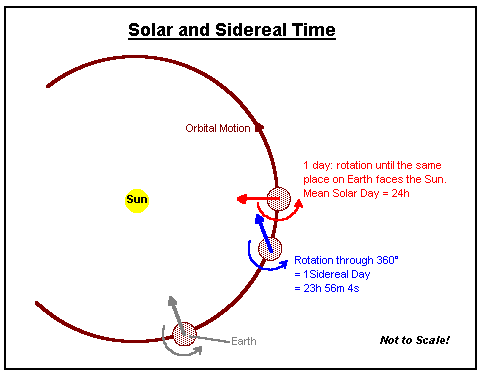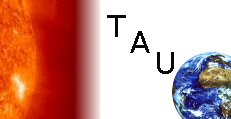This page last modified 1998 July 14
Time
Sidereal Time
Solar Time is time measured with respect to the Sun. Sidereal Time is time measured with respect to the celestial sphere.
Viewed from Earth, the celestial sphere rotates through 24h of RA in a Sidereal Day.

The Hour Angle (HA) of an object is its position, measured around the celestial equator, westward from the observer's meridian.

Local Sidereal Time (LST) = RA + HA
Greenwich Sidereal Time (GST) is the LST at the Greenwich
Meridian
Solar Time
Owing to the ellipticity of Earth's orbit (see Kepler's 2nd Law) and the obliquity of the ecliptic, the Sun does not appear to travel through the sky at a uniform rate. Mean Solar Time is referred to an imaginary body, the Mean Sun, which travels around the celestial equator (not the ecliptic!) at a constant rate of 360º per year.
Mean Solar Time is defined as the Hour Angle of the Mean Sun (HAMS) + 12h.
Solar Time is the time given by a sundial, i.e. the time given by the real Sun. It differs from Mean Solar Time by the Equation of Time (E). E can be as great as 16 minutes.
E = Solar Time - Mean Solar Time
The observable effect of this is that the position of the midday sun at 12h clock time will describe an irregular lemniscate, called the analemma, throughout the year.
Universal Time
Astronomers use Universal Time (UT). For most everyday purposes, this can be taken as the Mean Solar Time on the Greenwich Meridian (Greenwich Mean Time -- GMT). UT is actually calculated from sidereal time. UT0 is the result of this calculation. UT1 is corrected for Earth's "polar wobble". When "UT" is used by astronomers, it normally refers to UT1.
Co-ordinated Universal Time (UTC) is used for time-signal broadcasts. It is derived from International Atomic Time (TAI), from which it differs from a whole number of seconds. It is linked to UT1, from which it never differs by more than 0.9s -- hence the use of leap seconds to keep them in step.
References
A suitable for the beginning astronomer is given in both Chris Kitchin's Telescopes and Techniques and Gerald North's chapter in The Modern Amateur Astronomer.
Making sundials can be an instructive and enjoyable activity. There are two very good introductions to the subject in René Rohr's Sundials: History, Theory and Practice and Albert Waugh's Sundials, their Theory and Construction.


